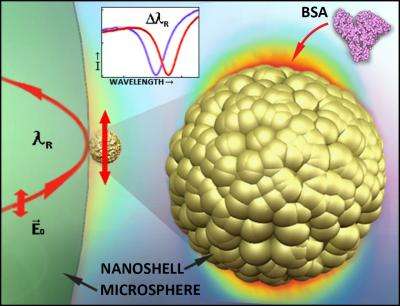Scientists reach holy grail in label-free cancer marker detection: Single molecules

Just months after setting a record for detecting the smallest single virus in solution, researchers at the Polytechnic Institute of New York University (NYU-Poly) have announced a new breakthrough: They used a nano-enhanced version of their patented microcavity biosensor to detect a single cancer marker protein, which is one-sixth the size of the smallest virus, and even smaller molecules below the mass of all known markers. This achievement shatters the previous record, setting a new benchmark for the most sensitive limit of detection, and may significantly advance early disease diagnostics. Unlike current technology, which attaches a fluorescent molecule, or label, to the antigen to allow it to be seen, the new process detects the antigen without an interfering label.
Stephen Arnold, university professor of applied physics and member of the Othmer-Jacobs Department of Chemical and Biomolecular Engineering, published details of the achievement in Nano Letters, a publication of the American Chemical Society.
In 2012, Arnold and his team were able to detect in solution the smallest known RNA virus, MS2, with a mass of 6 attograms. Now, with experimental work by postdoctoral fellow Venkata Dantham and former student David Keng, two proteins have been detected: a human cancer marker protein called Thyroglobulin, with a mass of just 1 attogram, and the bovine form of a common plasma protein, serum albumin, with a far smaller mass of 0.11 attogram. "An attogram is a millionth of a millionth of a millionth of a gram," said Arnold, "and we believe that our new limit of detection may be smaller than 0.01 attogram."
This latest milestone builds on a technique pioneered by Arnold and collaborators from NYU-Poly and Fordham University. In 2012, the researchers set the first sizing record by treating a novel biosensor with plasmonic gold nano-receptors, enhancing the electric field of the sensor and allowing even the smallest shifts in resonant frequency to be detected. Their plan was to design a medical diagnostic device capable of identifying a single virus particle in a point-of-care setting, without the use of special assay preparations.
At the time, the notion of detecting a single protein—phenomenally smaller than a virus—was set forth as the ultimate goal.
"Proteins run the body," explained Arnold. "When the immune system encounters virus, it pumps out huge quantities of antibody proteins, and all cancers generate protein markers. A test capable of detecting a single protein would be the most sensitive diagnostic test imaginable."
To the surprise of the researchers, examination of their nanoreceptor under a transmission electron microscope revealed that its gold shell surface was covered with random bumps roughly the size of a protein. Computer mapping and simulations created by Stephen Holler, once Arnold's student and now assistant professor of physics at Fordham University, showed that these irregularities generate their own highly reactive local sensitivity field extending out several nanometers, amplifying the capabilities of the sensor far beyond original predictions. "A virus is far too large to be aided in detection by this field," Arnold said. "Proteins are just a few nanometers across—exactly the right size to register in this space."
The implications of single protein detection are significant and may lay the foundation for improved medical therapeutics. Among other advances, Arnold and his colleagues posit that the ability to follow a signal in real time—to actually witness the detection of a single disease marker protein and track its movement—may yield new understanding of how proteins attach to antibodies.
Arnold named the novel method of label-free detection "whispering gallery-mode biosensing" because light waves in the system reminded him of the way that voices bounce around the whispering gallery under the dome of St. Paul's Cathedral in London. A laser sends light through a glass fiber to a detector. When a microsphere is placed against the fiber, certain wavelengths of light detour into the sphere and bounce around inside, creating a dip in the light that the detector receives. When a molecule like a cancer marker clings to a gold nanoshell attached to the microsphere, the microsphere's resonant frequency shifts by a measureable amount.
More information: pubs.acs.org/doi/abs/10.1021/nl401633y
Journal information: Nano Letters
Provided by New York University



















